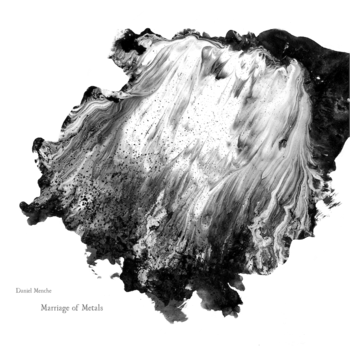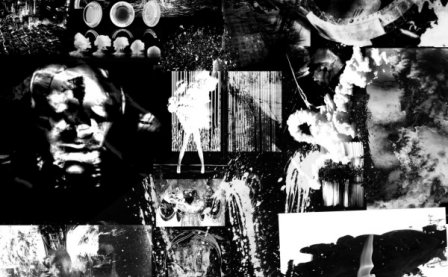American composer Lou Harrison had to build his own gamelan — he called it “Old Granddad” — using steel conduit tubing for keys, tin cans for resonators, galvanized garbage cans for drums, and oxygen tanks struck with baseball bats for gongs, but there are now over 100 gamelan ensembles in the United States. In any city that can muster a handful of people to protest against nuclear power, it’s hard not to stumble across a performance by a gamelan ensemble every once in awhile, but it’s more rare to get a chance to spend some quality time with the gamelan itself, especially the enormous Gong Ageng, which produces some of the deepest acoustic bass sounds audible to the ear. Portland-based sound artist Daniel Menche was granted access by the The Venerable Showers Of Beauty Gamelan ensemble at Lewis and Clark College to record their gamelan, and from those sessions he has produced Marriage of Metals, a consistently beautiful and intense drone piece in two parts.
On the album’s first side, the impressively plunging bass of the Gong Ageng rumbles beneath the track like the aftershocks of an inaudible earthquake, while metallophones emerge out of the static of their own sampled overtones. There are only a couple short, sampled phrases in the 17-minute track, and they buzz around one another, circling and elongating into sustained, distorted tones. As the track progresses, the samples become rough, abraded by a sandstorm of granular processing, and the metal tones go indistinct beneath a stinging assault, billowing and pulling taut like a flag in a strong wind. Impressively, Menche’s drones allow the listener to perceive both the sound of the gong and the physical disturbance created by the gong’s vibrations, as two separate sonic objects.
As a meditation on sonic relationships, Marriage of Metals is a modest success, but as an exploration of the gamelan’s fraught place within the history of Western experimental music, the album doesn’t seem to have much to say. Daniel Menche’s last album for Editions Mego, 2012’s Guts, was a bracing noise piece composed using a disemboweled piano, and upon first listen, it seems Menche is applying the same approach to his recordings in the Gamelan studio on this album. But what exactly should we call the source of these distressed sounds on Marriage of Metals? A gamelan is not strictly an instrument — I’ve seen the word translated in some academic articles as “orchestra,” because the term refers to the entire ensemble, rather than any particular instrument. So, as far as I can tell, it would be incorrect to hear the source of the sounds on the album as a gamelan; a single sound artist recording a few gongs and metallophones does not a gamelan make. Instead, what we have here are some samples of an experienced experimental musician messing around alone in the studio with some instruments from a gamelan.
So, what’s the difference between Marriage of Metals sourced from a gamelan or a garbage can lid? One might worry that the gamelan is being used as an exotic color in the sort of “decorative Orientalism” described by John Corbett in his article “Experimental Oriental: New Music and Other Others.” One might, and I did, until I took a moment to imagine the artist alone with his microphone, wandering through some storage room at Lewis and Clark College, the gongs and metallophones of the gamelan carefully laid out before him, but the players all gone. In my imagination, Menche leans down, tapping here and there, but the sounds he produces on his own don’t sound like a gamelan. Compared with the universe of metallic tones and thrilling rhythmic interplay of an entire ensemble, these tripping, struck tones sound small and lost, but they still trace over some of the same memories. Perhaps only a gong from a gamelan, ringing alone, can sound this abandoned.
Through the interpretations of Debussy, Satie, Cage, and Lou Harrison, among others, the gamelan has become associated with an ideal of musical compositions that develop cyclically rather than linearly. Later theorists have argued this simple opposition between linear and cyclical development is far less clear-cut than these modernists imagined, and in Marriage of Metals, Daniel Menche productively explores our complex recursive perception of the loop, including repetition’s uncanny simultaneity of self-similarity and difference, memory and anticipation, progression and regression. The entire second track seems to be based on a single loop, of halting bell-tones sounding at tranquil intervals, haloed with grainy rattles and shimmering static. Gradually, the sounds become rougher as the loop accumulates distortion and begins to change speed. It slows, as if sand was settling to the bottom of a disturbed pool, and high shimmering overtones separate from the grainy low-end remains. The sonic space opens up into these two bands, and gradually the tones lose even their rhythmic relationship with one another.
As I imagine it, alone in the studio, Menche has turned his first explorations of the gamelan — a lonely throb of gong, some struck metal — into an entire soundscape, fully populated with complex relationships and internal struggle. If Marriage of Metals has something to say about marriage, then it’s about parting, about the relationships that you form with your memory of others. The kind of separation, of any length, that leaves you feeling closer to the one you are recalling, closer to understanding, closer to the memory’s surface, with each passage.
More about: Daniel Menche




